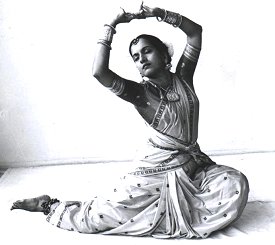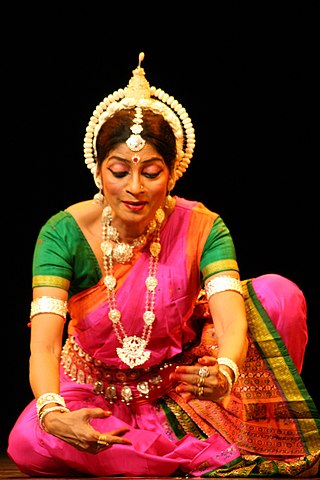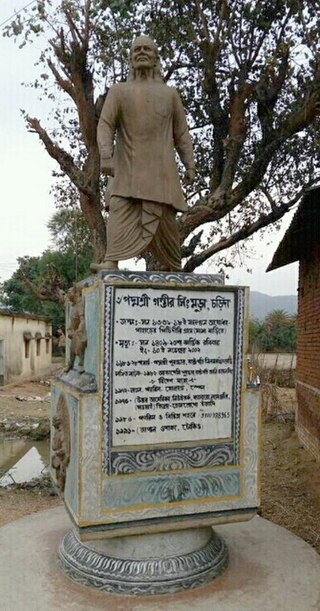Gopal Prasad Dubey | |
|---|---|
| Born | 25 June 1957 |
| Died | November 14, 2022 (aged 65) |
| Occupation | Classical dancer |
| Years active | Since 1971 |
| Spouse | Nalini gopal |
| Children | 2 |
| Awards | Padma Shri Sangeet Natak Akademi Award 2016 Life time achievement award 2017 from CMSB New Delhi Vocational Achievement AwardContentsJharkhand State Award Suvarna Shankhu Award Natya Shri Puraskar Golden Conch Award Natya Tarang Puraskar Natya Keerthi Shikha Puraskar Natya Veda Puraskar |
| Website | Official web site |
Gopal Prasad Dubey is an Indian classical dancer, known for his expertise in the Indian classical dance form of Chhau. [1] [2] [3] He is considered by many as the leading exponent of the Seraikella variant of the art form. [4] Dubey was honored by the Government of India, in 2012, with the fourth highest Indian civilian award of Padma Shri. [5]
Gopal Prasad Dubey was born on 25 June 1957 in a Brahmin family at Seraikella, in the Indian state of Bihar (now Jharkhand). [6] [7] [8] [9] He started training Chhau at the age of 14 [4] under renowned gurus such as Rajkumar S. N. Singhdeo, Kedar Nath Sahoo, both Padma Shri award winners [5] and Natasekhar Banbihari Pattanayak. [7] [8] [9] [10] He also had training in New York, under a grant provided by the Asian Cultural Council. [9]
Dubey founded Trinetra, an institution for promoting Chhau dance, [11] in 1985, [4] under the aegis of which he has performed at many places across the world. [11] He has worked as the faculty member for dance at the Panjab University, Chandigarh. [8] [7] He has also worked with many international universities such as the University of Kansas, Indiana University of Pennsylvania, Harvard University, University of London, Chungang University, Seoul, Seoul Institute of the Arts and American College of Greece and has taught at the Theatre Group and Multi Cultural Centre, both based in Inchon, South Korea. [8] [7] [10]
Dubey presented two classic plays, Antigone, in 1984 in New York and Shakuntalam, in 1987 at the Volos Theatre in Greece. [7] [10] His compositions were included in Bharat Ek Khoj , a TV series produced by the renowned film makerShyam Benegal. [8] He is also credited with the choreography of productions and presentations such as:
An approved artist of the Indian Council for Cultural Relations, [7] [2] a Government of India agency, Gopal Prasad Dubey has travelled in many parts of the world with his performance, [9] which includes a performance at Symphony Space, Broadway, New York [10] [7] and has conducted many workshops and demonstrations in India and abroad. [11] [7] [10] [9] He has also collaborated with mainstream cinema and experimental theatre. [1] [4] [7]
Gopal Prasad Dubey lives in Bengaluru, Karnataka. [6]
Gopal Prasad Dubey is a recipient of the Vocational Achievement Award from Rotary Club International. [8] He received the Jharkhand State Award in 2007 for his contributions in promoting Chhau dance. [7] [10] [8] He was awarded Suvarna Shankhu at the Keli Chhau festival in 2010. [8] [7] The same year, he received the Natya Shri title from Nataraj Music Academy [7] [10] and Golden Conch from Keli Foundation, Mumbai. [10]
Holder of a senior fellowship from the Ministry of Culture, Dubey was honored by the Government of India in 2012, with the fourth highest civilian award of Padma Shri. [7] He also received Natya Tarang Puraskar from Nataraj Music Academy and Natya Keerthi Shikha Puraskar from Sathyanjali Academy, Cochin, both in 2013 and Natya Veda Puraskar from Nataraj Music Academy in 2014. [10]

Indian classical dance or Shastriya Nritya is an umbrella term for various performance arts rooted in Hindu musical theatre styles, whose theory and practice can be traced to the Sanskrit text Natya Shastra. The number of classical dances range from eight to more, depending on the source and scholar. The Sangeet Natak Academy recognizes eight – Bharatanatyam, Kathak, Kuchipudi, Odissi, Kathakali, Sattriya, Manipuri and Mohiniyattam. Scholars such as Drid Williams add Chhau, Yakshagana and Bhagavata Mela to the list. Additionally, the Indian Ministry of Culture includes Chhau in its classical list. These dances are traditionally regional. They consist of compositions in Hindi, Malayalam, Meitei (Manipuri), Sanskrit, Tamil, Odia, Telugu, or any other Indian language and they represent a unity of core ideas in a diversity of styles, costumes and expression. Currently, there are 9 official classical dances in India.

Chhau dance, also spelled Chhou dance, is a semi classical Indian dance with martial and folk traditions. It is found in three styles named after the location where they are performed, i.e. the Mayurbhanj Chhau of Odisha, the Seraikella Chhau of Jharkhand, and the Purulia Chhau of West Bengal.

Mungara Yamini Krishnamurthy is an Indian dancer of Bharatanatyam and Kuchipudi styles of dancing.

Damayanti Joshi was a noted renowned exponent of the Kathak dance form.She believed Kathak is the art of storytelling. She began in the 1930s dancing in Madame Menaka's troupe, which travelled to many parts of the world. She learnt Kathak from Sitaram Prasad of Jaipur Gharana and became an adept dancer at a very young age, and later trained under from Acchan Maharaj, Lacchu Maharaj and Shambhu Maharaj of Lucknow gharana, thus imbibing nuances from both the traditions. She became independent in the 1950s and achieved prominence in the 1960s, before turning into a guru at her dance school in Mumbai.
Gangadhar Pradhan was an Indian Odissi dancer.

Parshwanath Upadhye is an Indian classical dancer, choreographer and teacher. He is trained in the traditional Mysore style of Bharatanatyam.

Maya Rao was an Indian classical dancer, choreographer and educator, in Kathak dance. She is known for her pioneering work in Kathak choreography, especially in dance ballets, and is credited for bringing Kathak, a North Indian-dance style to South India, when she opened her dance school, Natya Institute of Kathak and Choreography (NIKC) in Malleswaram, Bangalore in 1987. She was also the founder director of her dance company, "Natya and Stem Dance Kampni", an amalgam of NIKC and the STEM Dance Kampni based in Bangalore. After her early training under Guru Sohanlal of Jaipur Gharana, followed by Guru Sunder Prasad also of the Jaipur Gharana, and went to train under Guru Shambhu Maharaj of Lucknow Gharana at National Institute of Kathak Dance in Delhi.
Madras Kadiravelu Saroja, is an Indian classical dancer, known for her expertise, as an exponent and as a teacher, in the classical dance form of Bharatanatyam. The Government of India honored her, in 2011, with the Padma Shri, the fourth highest civilian award, for her services to the field of art and culture.

Geeta Mahalik is an Indian Odissi dancer. The Government of India honoured her with the Padma Shri in 2014 for her services to the field of art and culture.

Mukund Lath was an Indian scholar and cultural historian, known for his writings on music, dance, aesthetics and culture of India. He was honored by the Government of India, in 2010, with the fourth highest Indian civilian award of Padma Shri.

Gambhir Singh Mura was an Indian tribal dancer known for his contributions to the tribal martial dance of Chhau. He was an exponent of the Purulia school of Chhau.
Roshan Kumari Fakir Mohammad is an Indian classical dancer, actor and choreographer, considered by many as one of the foremost exponents of the Indian classical dance form of Kathak. She follows the Jaipur Gharana and is the founder of Nritya Kala Kendra, Mumbai, an academy promoting Kathak. A recipient of the Sangeet Natak Akademi Award in 1975, she received the fourth highest Indian civilian honour of Padma Shri from the Government of India in 1984.
Shobha Deepak Singh is an Indian cultural impresario, photographer, writer, classical dancer and the director of Shriram Bharatiya Kala Kendra, a Delhi-based cultural organization which promotes music and performing arts, through its schools and stage shows. She is known for her contributions for the revival of Mayurbhanj Chhau, a tribal martial dance form from Odisha. The Government of India awarded her the fourth highest civilian award of the Padma Shri in 1999, for her contributions to Arts and culture.
Komala Varadan is an Indian classical dancer of Bharatnatyam, writer and the founder of Kalaikoodam, a Delhi-based institute for promoting arts, literature and culture. She is known to be proficient in various art forms such as choreography, photography and painting.
Shyama Charan Pati was an Indian dancer, known as one of the leading exponents of the Seraikala tradition of Chhau, a martial dance form of India. He was a member of the Court of the Central University of Jharkhand.
Meenakshi Chitharanjan, an Indian classical dancer, teacher and choreographer, is known as an exponent of the Pandanallur style of the classical dance form of Bharatanatyam. She is the founder of Kaladiksha, an institution promoting Bharatanatyam and striving to preserve the Pandanallur tradition. A disciple of the father-son duo of Chokkalingam Pillai and Subbaraya Pillai, she is a recipient of several honours including Kalaimamani Award of the Government of Tamil Nadu and the Natya Kala Sarathi of Sri Parthasarathy Swami Sabha. The Government of India awarded her the fourth highest civilian honour of the Padma Shri, in 2008, for her contributions to classical dance.
Kedar Nath Sahoo was an Indian classical dancer, known as one of the leading exponents of the Seraikella tradition of Chhau dance. He served as the founder director of the Government Chhau Dance Centre of the Government of Jharkhand where he served from 1974 to 1988. During the early stages of his career, he performed with the troupe led by Kumar Bijay Pratap Singh Deo, but later led his own group of dancers for performance in many places in India and abroad including Eastern Europe, South America and Southeast Asia. His students included many notable dancers like Sharon Lowen, Gopal Prasad Dubey and Shashadhar Acharya. He was a recipient of the 1981 Sangeet Natak Akademi Award and the Government of India awarded him the fourth highest civilian honour of the Padma Shri, in 2005, for his contributions to arts. Towards the latter part of his life, his health failed and he died on 8 October 2008 at his home in Kansari tola, aged 88, survived by his wife, five sons and four daughters.

Dr. Pt. Nandkishore Kapote is a leading senior exponent of Kathak, an Indian classical dance form. He is a senior disciple of Pandit Birju Maharaj. He is the Artistic Director of the Nandkishore Cultural Society. He is also the Director at Dr. D. Y. Patil School of Liberal Arts and Ph.D. guide at Sri Sri Centre for Kathak Research
Madhu Nataraj is an Indian classical, contemporary dancer and choreographer who lives in Bangalore. She is the director of the Natya Institute of Kathak and Choreography and founded its performing wing STEM (Space.Time.Energy.Movement) Dance Kampni.

Narthaki Nataraj is an Indian transwoman Bharatanatyam dancer. In 2019, she was awarded the Padma Shri, making her the first transgender woman to be awarded India's fourth-highest civilian award.